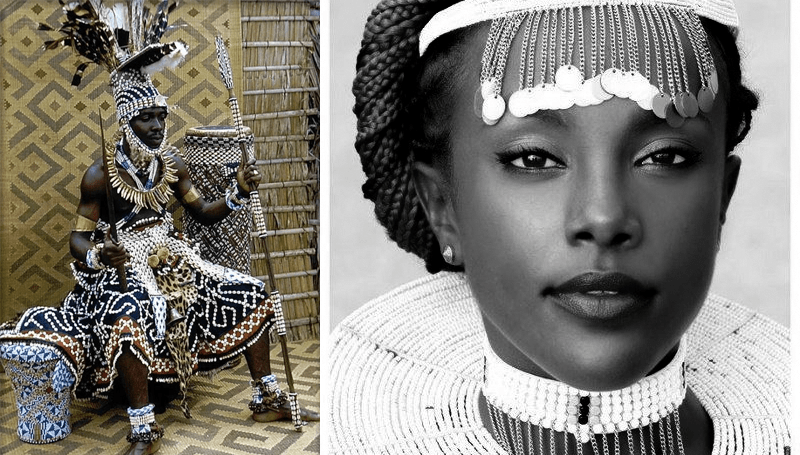The Kuba Kingdom, also known as the Bakuba Kingdom or Bushongo, is a traditional Central African kingdom. The Kuba Kingdom flourished between the 17th and 19th centuries in the heart of the modern-day Democratic Republic of the Congo, bordered by the Sankuru, Lulua, and Kasai rivers.
The Kuba Kingdom was a federation of several smaller Bushongo-speaking principalities, as well as the Pygmies of Kete, Coofa, Mbeengi, and Kasai Twa. The original Kuba came from the north during the 16th century. The kingdom, which still exists and is ruled by the King, includes nineteen different ethnic groups.
The kingdom began as a federation of several chiefdoms representing various ethnic groups, with no real central authority. Shyaam a-Mbul a Ngoong, a person from outside the area, usurped the position of one of the area rulers and united all the chiefdoms under his leadership around 1625. According to legend, Shyaam a-Mbul was the adopted son of a Kuba queen. He left the Kuba region to seek enlightenment in the kingdoms of Pende and Kongo to the west. After learning everything he could from these states, he returned to Kuba to lay the political, social, and economic foundations of the empire.
A new administration
The Kuba government was reorganized toward a merit-based title system, but the aristocracy retained absolute power. The Kuba government was ruled by the Bushoong clan’s king, known as the nyim. The king was accountable to a court council comprised of representatives from all Kuba subgroups, who were represented equally before the king by their elites. The kingdom had an unwritten constitution, elected political offices, a judicial system with courts and juries, a police force, a military, taxation, a significant public goods provision, and socially supportive movements.
Growth
As the kingdom grew older, it benefited from advanced techniques learned from neighboring peoples, as well as New World crops brought over from the Americas, such as maize, tobacco, cassava, and beans. Kuba’s wealth resulted in great artistic works commissioned by the Kuba nobility. The Kuba kings kept the most ornate works for court ceremonies and were buried with them.
Apex
The Kuba Kingdom reached its zenith in the mid-nineteenth century. The area was first visited by Europeans in 1884. Because of its relative isolation, the Kongo and Ndongo kingdoms on the coast were not as affected by the slave trade.
Kot-a-Mbweeky III, the current monarch, has been on the throne since 1968.
Kuba tradition
Kuba art
The Kuba are famous for their monumental helmet masks, which feature exquisite geometric patterns, stunning fabrics, seeds, beads, and shells, as well as raffia embroidered textiles, fiber and beaded hats, carved palm wine cups, and cosmetic boxes.
The boxes are referred to as Kuba. Boxes, known as ngedi mu ntey by the Kuba, are commonly used to store tukula powder and paste. The boxes are usually shaped like a square with a faceted lid, a semicircle (also known as a “half moon”), a rectangle, or a mask. They were sometimes used to hold razors for cutting raffia, hairpins, or ritual objects.
Tukula (twool in Kuba) is a red powder made from ground cam wood. Because the color red is so important to the Kuba concept of beauty, it was used to decorate the face, hair, and chest during dances and important ceremonies, as well as to anoint bodies for burial. Tukula was also combined with other pigments to color raffia fabric.
After 1700, King Misha mi-Shyaang a-Mbul introduced ndop figures, which were carved to look like the king and represent his individual reign. These figures always included the king’s ibol, or personal symbol, which functioned similarly to a personal standard.
The carved palm-wine drinking cups and ornately carved boxes are associated with competition among the Kuba’s titled court members. Competition for influence was sometimes fierce in the 1880s, with half of all Bushoong men holding titles, and it found expression in the elaboration of these essentially commonplace household objects into works of extraordinary beauty.
Kuba mythology and religion
Bumba the Sky Father, who spewed out the sun, moon, stars, and planets, was revered by the Kuba. He also gave birth to life with the Earth Mother. However, these were distant deities, and the Kuba were more concerned with Woot, a supernatural being who named the animals and other things.] Woot was the first human being and the originator of civilization. The Kuba are also referred to as the “Children of Woot.”
 The African History Truly African
The African History Truly African

